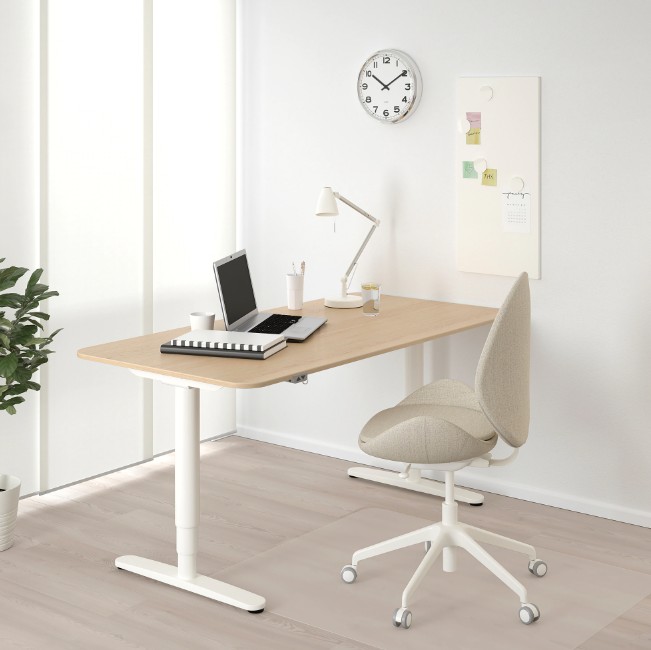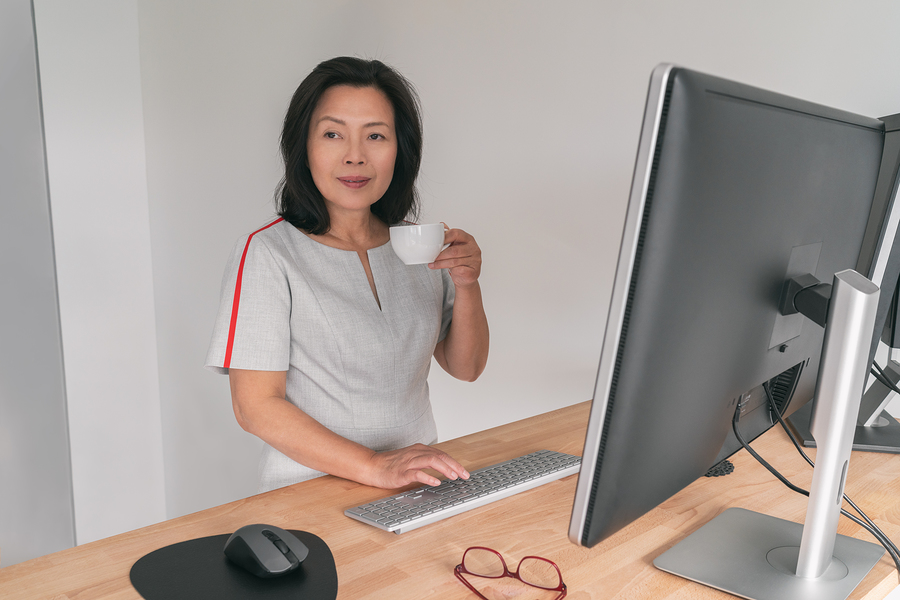As the world has turned more to desk jobs with the advent of technology in the majority of industries, some strange problems have made themselves apparent. As it seems, sitting for eight or more hours a day to fill in spreadsheets or handle memos isn’t exactly healthy.
Not only is this a very sedentary lifestyle, but there are unique health problems that can start to crop up the longer you remain sitting in your cubicle.
A common solution to this problem is a “standing desk”. A standing desk is a desk option that, as the name implies, you stand at. It’s a bit higher, and everything else is the same, but you stand instead of sitting all day.
There are several benefits that you can enjoy by adopting a standing desk or sit/stand combo desk into your daily work routine.
Check it out.
5 Main benefits of using a standing desk:
1: Better circulation
Have you ever felt a slight sense of numbness in your legs or arms while sitting at your desk for a long period of time? Typically this goes away if you reposition, but that’s only a minor fix. There’s a much bigger underlying problem going on.
When you’re sitting all day, your body isn’t circulating blood like it’s supposed to, and this can wreak havoc on your overall health over time.
A standing desk promotes better blood flow, and you’ll quickly see a lot of circulatory system problems disappear once you start using a stand desk.
2: Reduced back pain
No matter what office chair you use or what fancy features it has, sitting down for long periods of time is not good for your back. You probably already experience stiffness in the back with occasional pain. This is because your back muscles aren’t moving, they get stiff, and if you’re sitting improperly, you’re putting undue stress on them.
A standing desk will help relieve those problems on day one.
3: Reduced shoulder pain
This is the same problem that you’re experiencing with your back, but it’s more related to how you’re positioning your arms to type. Your hands and forearms might be moving, but your shoulders likely see a very little movement and remain in an unnatural position throughout your shift.
A standing desk allows your shoulders to assume a natural position while you’re working, and you’ll naturally move them around more. This reduces stiffness and pain considerably.
4: Reduced hip and joint pain
This might not be noticeable at first, because you’re not used to standing for long periods of time, but within a few weeks, you’ll notice dramatically reduced hip and joint pain.
When you’re sitting all day, your hips are compressed. This makes them stiff and often causes pain, but it also creates problems for all the joints attached to them.
Your body will need to adjust to standing for long periods of time, but once you do that, your hips and joints will feel great.
5: Increased productivity
Finally, you’ll be far more productive. A body in motion stays in motion. If you’re standing, you’re not going to hesitate to move around the office and do what needs to be done, you won’t be as easily distracted by unproductive activities, and you’ll generally be more focused on your work.
This can be the difference between improving your performance and excelling at work or staying in the same spot for years.

5 Tips for using standing desks correctly
1. Adjust the time for sitting and standing
While sitting for extended periods of time can have negative effects on your health, standing all day is not the solution. Research has linked standing occupations, such as bank tellers and production line employees, to lower back pain, and standing still for long periods can negatively affect leg muscles, tendons, and other connective tissues, and even lead to varicose veins.
The solution to this problem is to alternate between sitting and standing. While the research is still in its early stages, a 1:1 or 2:1 ratio of sitting to standing time appears to be optimal for comfort and energy levels, without affecting productivity (2Trusted Source). Aim to alternate between sitting and standing every 30 to 60 minutes, with one hour of standing for every 1 to 2 hours of sitting.
2. Adjust the position
Achieving the correct desk height and computer screen position is essential for enhancing comfort and minimizing injury risks in the workplace.
To ensure proper ergonomics, set your standing desk at elbow height, which means your elbows should form a 90-degree angle with the floor. For an average person who is 180 cm tall, the desk height should be about 111 cm high.
When it comes to screen position, experts suggest having it placed between 51-71 cm away from your face, although there is no hard and fast rule. A quick guide is to keep the distance no less than the length between the tip of your middle finger and elbow.
The top of your computer screen should align with your eye level, with a slight upward tilt of 10 to 20 degrees, so that you never have to tilt your neck up or down.
3. Use standing matt
Anti-fatigue mats are frequently utilized in professions that require extended periods of standing, such as working on a production line or at a counter, to combat standing fatigue.
These mats work by promoting subtle movements of your leg muscles, which enhances blood flow and reduces overall discomfort.
According to studies, individuals who stand for two or more hours per day report less discomfort and tiredness when utilizing anti-fatigue mats. Moreover, the mats assist in addressing leg issues and lower back pain.
If you suffer from leg or lower back pain while standing, anti-fatigue mats may be a valuable investment. You can purchase them online.
4. Maintain proper wrist position
To prevent wrist strain when working on a computer for long hours, it’s essential to maintain proper wrist position whether you’re sitting or standing.
When standing, your wrists should be slightly more extended (tilted upwards) compared to when sitting. Failing to consider this difference for those who frequently switch between sitting and standing has been found to cause increased wrist pain and discomfort.
To safeguard your wrists when standing, ensure that your keyboard and mouse are at the same level, and keep your wrists straight when typing.
If you still experience wrist soreness from time to time, you may want to consider using an adjustable keyboard stand and gel mouse pads to provide optimum support.
5. Support your arms
An arm support is a cushioned padding or surface area that can be attached to your desk. Its purpose is to alleviate pressure on the wrist that controls the mouse.
Studies have extensively researched this topic, and the findings indicate that arm supports can greatly decrease the likelihood of developing neck and shoulder issues.
If you frequently encounter these problems, particularly on the side of your dominant hand, it is worthwhile to explore using arm supports.

FAQ about Standing Desk Usage:
How long should you stand at a standing desk?
Experts suggest that when using a standing desk, it’s best to stand for 5-15 minutes per hour, although research is still ongoing. According to a study, it is recommended to move, stand, and take breaks from sitting for at least 2 hours during an 8-hour workday.
Is it OK to stand all day at a standing desk?
Standing all day at a standing desk can cause lower back pain, leg muscle and tendon problems, and even varicose veins. A study published in the Ergonomics journal in 2017 found that standing for long periods can cause discomfort and reduce reaction times. It is important to alternate between sitting and standing and take regular breaks to avoid these negative effects.
How many hours a day should you stand at a standing desk?
It is recommended to alternate between sitting and standing every 30 to 60 minutes. According to early research, the optimal ratio for sitting and standing time is 1:1 or 2:1, meaning for every 1 to 2 hours of sitting, you should spend 1 hour standing.
Is it better to sit or stand all day?
According to a University of Waterloo professor, sitting for prolonged periods can negatively impact your health. To combat this, experts have recommended standing for 15 minutes per hour at your workstation. However, recent research suggests that standing for at least 30 minutes per hour can provide greater health benefits.
Does sitting too much age you?
Sitting and low physical activity may accelerate aging in older women. As a cell ages, its telomeres naturally shorten and fray, but health and lifestyle factors, such as obesity and smoking, may accelerate that process. Shortened telomeres are associated with cardiovascular disease, diabetes and major cancers.
Why can I barely walk after sitting?
Experiencing a sense of instability or imbalance on your feet after sitting for an extended period is a common occurrence. The cause of this sensation can be attributed to a range of factors, including decreased blood flow, tense muscles and ligaments, accumulation of fluid in the lower body, or tingling sensations in the feet.
Does sitting change your body shape?
Prolonged sitting can cause the major leg and gluteal muscles to become weaker and atrophy. These muscles are crucial for maintaining stability and walking.


